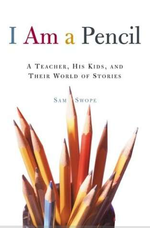I Am a Pencil by Sam Swope


First, meet Mr. Swope. Here, in the first chapter, he introduces himself.
I’m not a famous writer now and wasn’t then, nor had I published much—nothing in some time. Still, I kept going through the motions, throwing words at the computer, screen after screen of promising beginnings, bits of characters, half thoughts, every day more words; but they never added up to anything, not book had taken shape in much too long, and I had grown discouraged.
Then—-something happens. He gets asked by Teachers and Writers Collaborative to give a workshop to a classroom of third-graders in Queens. He is slated to work with them for ten days. He ends up staying with them for three years, seeing them off, in the bittersweet final chapters, to middle schools scattered throughout New York.
Sam Swope is the kind of magical teacher one might wish for one’s own children—or for one’s own child self. He’s passionate about stories—but not puffed up in any way. There’s something humble and honest and refreshing about him. He reads with the children. Writes with them. Walks with them—dozens of times?—to Central Park to sit beneath the trees and write.
Perhaps the best way to meet Mr. Swope and his pencil book is to meet him as he teaches, this beginning in the first several paragraphs of his preface which I am typing out here because, well, I love this beginning. I love the way he invokes the mystery of Wallace Stevens’ poem with these children.
So, from the preface, entitled, The Blackbird is Flying
Among twenty snowy mountains,
The only moving thing
Was the eye of the blackbird.
My students put their elbows on their desks and leaned over the poem. I’d been teaching writing to this class for three years, since they were in third grade. I knew them well. They were a smart group, immigrants or the children of immigrants to Queens, New York. They came from twenty-one countries and spoke eleven languages. A majority were from Latin America, and most of those were from Ecuador, but Colombia, Cuba, the Dominican Republic, Guyana, and Uruguay were also represented. Two had Puerto Rican fathers. Ten were listed on the roster as Asian, but that covered a lot of ground, including Bangladesh, Cambodia, China, Hong Kong, India, Korea, Pakistan, Taiwan, Thailand, and Vietnam. One student was Turkish. The class also had an Egyptian boy and a half-Croatian, half-Bosnia-herzegovinian girl, but they’d since moved.
The kids knew English, more or less, but some still thought in their native tongues, and I could see them translate what I said inside their heads. Most were poor, their sights set on doctoring as the clearest way up the American ladder, and although they enjoyed reading and writing, they thought math and science were the only subjects that really mattered.
Their fifth-grade classroom was crowded, not much space for anything but students, tables, and chairs. But it was a bright, tall room, at the top of a fat old brick schoolhouse. Its ceilings were high; the windows started eight feet up the wall, so that even when standing you had to look up to look out. All you ever saw was sky. It was like being in a deep box with the lid ajar.
Stevens writes of twenty snowy mountains. It was late January, nearly seventy degrees and sunny. We were hot. ‘El Nino!’ cried my students. “Global warming!’ What could they know of mountains and blackbirds? The school had no recess, and when the kids were not in class, most were stuck in tiny apartments, forbidden to play in the city streets.
The room was silent as the children read.
Well, how wonderful is that. A deep box with the lid ajar. And, inside this box, the deep silence of Wallace Stevens’ poetry–and children reading.
_____________________________________________________________________
